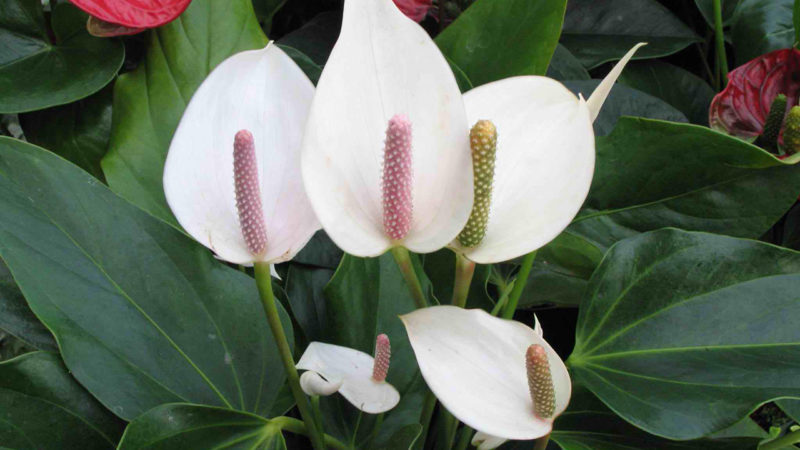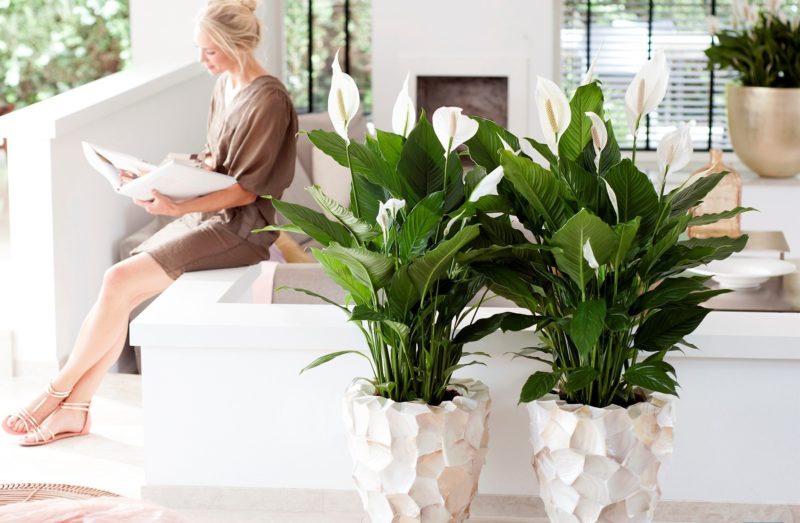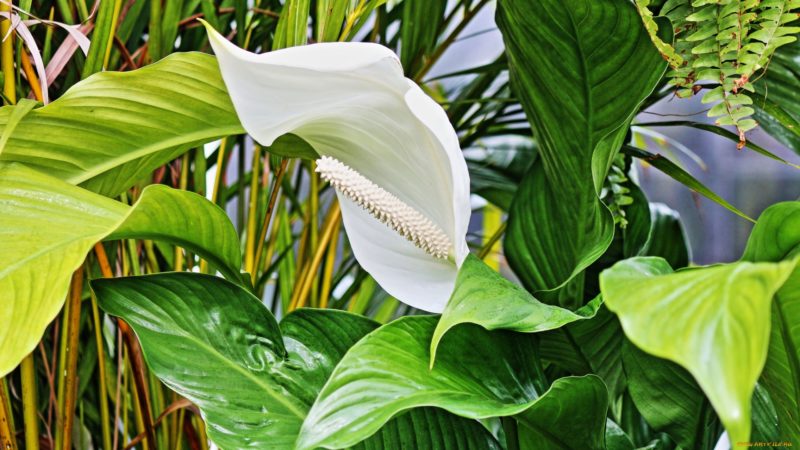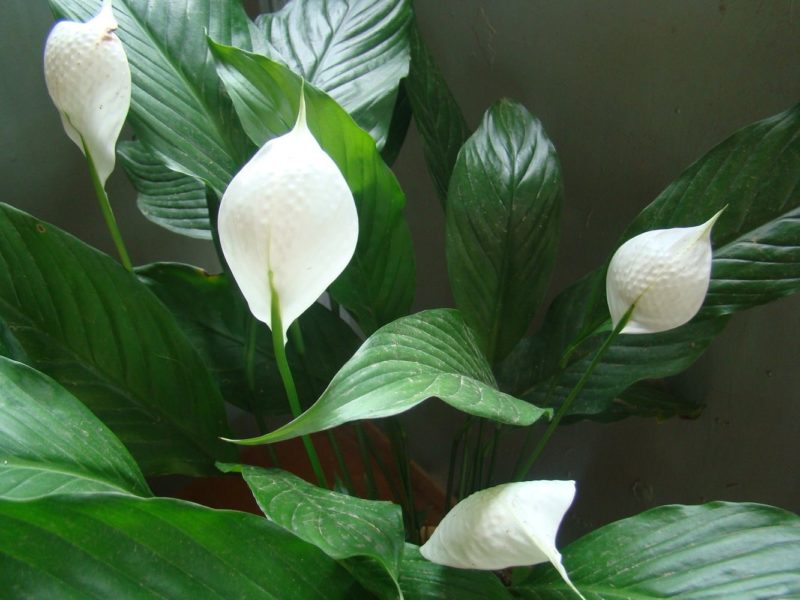The correct name of this flower is spathiphyllum, and it grows in nature in South America, near reservoirs. Therefore, in order for the plant to feel “at home” and, accordingly, to bloom, the air in the room must be warm and sufficiently humid.
Although spathiphyllum is quite unpretentious, some points in caring for it are still worth sticking to.
Material Content:
Flower “Women's happiness” - how to care for blooming?
In order for a plant to begin to bloom, it is necessary to provide the most important conditions for its growth and development. This is a sufficient, but not excessive, amount of light, the required air temperature, watering, fertilizing. And now - in more detail about each of these points.

Location and lighting
Spathiphyllum “Feminine Happiness” loves light, but at the same time, direct sunlight should be avoided, especially in the summer. You can put a pot of plants on the windowsill of the north window. If spathiphyllum has to be on the southern window, on fine days it is blocked with a thin sheet of paper, tulle, gauze. You can also place it on a table or shelf - not far from the window.

The plant will suffer a lack of light, but at the same time its appearance may change for the worse: the spathiphyllum will become smaller, and its flowering will stop.
The best place for a flower pot is at a window facing east.
Temperature and humidity
With regard to temperature, “Women's happiness” is by no means capricious. Optimally, if the air is warmed up to + 20-25 C. But even on hot summer days, the plant will feel good, will withstand + 30-35 C.
As for winter, the room can be quite cool + 15-18 C.A natural decrease in air temperature in the winter period also occurs in the homeland of spathiphyllum. It is important that the room was not below + 15 C.

Humidity is of secondary importance if “Feminine Happiness” is watered correctly. And yet, if the air in the room is too dry (this often happens during the winter season when central heating works), the batteries can be covered with a thick, damp cloth and changed as they dry.
Watering and spraying
Like other indoor plants, it is undesirable to water a spathiphyllum with tap water freshly drawn from a tap. The water is pre-sedimented (during this process chlorine, harmful to the flowers, comes out of it), warmed to room temperature.
Those who live in environmentally friendly areas can use rainwater or melt water for irrigation. Another option is to let water through the filter.
In summer, spathiphyllum is watered after 1-2 days, depending on the air temperature. In winter, watering is carried out less frequently: once every 7-10 days.
There is a sure sign that the plant needs to be “watered” immediately. In this case, the leaves begin to fall.
If the owners have to leave for a few days, and there is no one to look after the flowers - the output may be pallets in which there are pots. They are filled to the brim with water.
The leaves of spathiphyllum also require care: they must be periodically wiped with a damp cloth, or sprayed from a special small spray bottle. It is important that direct sunlight does not fall on wet leaves - this can cause them to burn.
Necessary for “Women's happiness” mixture and top dressing
Since spathiphyllum blooms from April to October, the main feeding is carried out at this time, about once a month. You can use any fertilizer for indoor plants that are commercially available and use them according to the instructions. It is advisable to alternate mineral fertilizers with organic ones.
In winter, during the dormant period, “Feminine Happiness” does not need to be fed.
Once every 3-4 years, the flower is transplanted into a pot, somewhat larger in volume. This is a very important point. It must be remembered that spathiphyllum will not bloom until its roots cover the entire soil. Therefore, the size of the new pot should not be excessively large.
As for the soil itself and the transplant process, you need to be guided by the following rules:
- It is best to transplant a plant in the spring, when it has not yet entered the flowering phase;
- should be mixed in equal proportions peat, humus and land. You can add some river sand. The optimal ratio of 2: 2: 2: 1;
- as drainage, bark, sawdust, charcoal are placed at the bottom of the pot;
- it is advisable to transplant spathiphyllum together with a lump of earth, which is entwined with roots.
For some time, a transplanted flower should not be placed in a highly lit place.

As you can see, it’s quite easy to take care of the “Feminine Happiness” flower.
Why does not the feminine happiness spathiphyllum bloom?
You can buy spathiphyllum in almost every indoor flower shop. As a rule, they try to put it up for sale at the most “winning” time when the plant is blooming.
But “Feminine Happiness” has found a new owner, and does not want to bloom the next year.

What reasons can this have?
- too big pot. In this case, flowers will appear when the roots “conquer” an entire new space;
- insufficient watering - the leaves wither, and their tips dry out;
- excess moisture can lead to stagnation of water in the soil and rotting of the roots;
- the insects pests - aphids, spider mites. It will be necessary to treat the plant with special preparations;
- imbalance of minerals: Spathiphyllum not only refuses to bloom, but its leaves begin to blacken, starting at the tips. If fertilizers have not been applied under the plant for a long time, then it's time to do it. But do not overdo it! Too concentrated fertilizers can also be harmful.
- the soil is not compacted enough.In this case, even young leaves do not develop well, let alone the appearance of flowers!
- hypothermia: a rare reason for the lack of flowering in indoor plants, but this also happens. For example, if you take out the pots in the early spring on the balcony.
It is worth considering which of the above reasons may relate to a particular flower, and eliminate problems.
And finally, one more “secret” from experienced gardeners: as soon as the flowers “grow old”, the peduncle should be cut closer to the root. Then the plant will not spend energy on maintaining the “life” of what has blossomed, and new flowers will be large - on strong peduncles.
It is believed that “Feminine Happiness” is not in vain received the name - the plant brings peace and love to families. Whether this is so is difficult to say. But the fact that it will be pleasant for all households to look at beautiful flowers is for sure.
May your “Feminine Happiness” regularly please you with abundant flowering.












